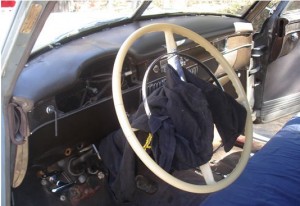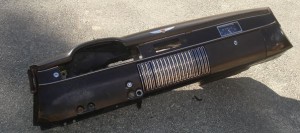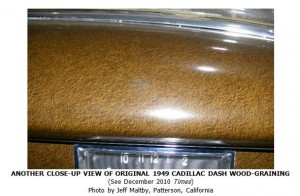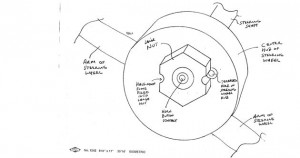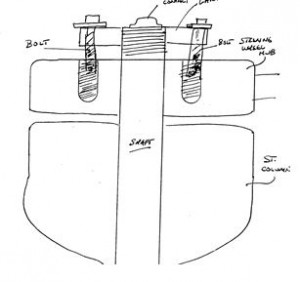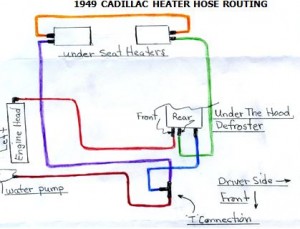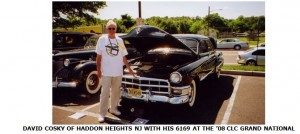Recently the speedometer head on my ’49 Coupe de Ville developed a screeching noise that was loud and about as welcome as fingernails scratching a chalk board. If you follow the steps listed below you can fix your speedometer, also.
Disconnect the ground cable from the battery. Wrap a towel around the steering column and secure it with tape. Apply tape to towel, not the paint. Lie underneath the dash with a good light. Remove the 2 wing nuts that secure the instrument cluster to the dashboard. Loosen the nut at the bottom of the dash for the trip odometer. Make sure there is enough slack in the oil pressure tubing to allow the cluster to move forward a couple of inches; if not, disconnect the oil pressure tube now. Push and wiggle the instrument cluster toward steering wheel about two inches. Be patient. It’s been there for 60 years and it may want to stick. Return to sitting position in your front seat. Your back will appreciate this. Now you can lean forward and view the backside of the entire cluster. You can also pull the cluster a little closer to your body to have easier access to everything connected to it.
You MUST mark all wires and bulb fixtures BEFORE unplugging them from the instrument cluster housing. I recommend using masking tape on each wire, numbering everything from left to right and writing those numbers down. Unplug all wires from the gauges, all bulb fixtures, and unscrew the speedometer cable nut and pull cable out. You must also remove the oil pressure gauge tubing. Use caution. Use an open end wrench to secure the gauge fitting as you loosen the tubing fitting so as not to damage the gauge. A 6 point tubing wrench is best for the tubing nut. Do not damage the nut. Unscrew the odometer reset cable at the speedometer housing and pull it out. With everything disconnected you can remove the entire cluster from the dash, while taking care not to bump any painted surfaces, and place it on your workbench face down against a soft cloth.
Remove the 2 screws that go through the rubber grommets near the connection for the speedometer cable. Keep all screws and fasteners in a shallow pan or other suitable container since you don’t want to lose anything! Remove 4 screws that hold the galvanized cover to the speedometer head. Gently place a thin screwdriver between the cover and main housing and pry it away from the head AS you hold the head downward. It may stick because there is a rubber gasket between the cover and head. SAVE the rubber gasket and grommets. Now you will be able to view the speedometer head. It is a delicate instrument so be careful handling it! You will see 2 tabs about an inch long that are bent over the edge of the head to secure it during assembly at the factory. Bend them sideways just enough to allow sufficient clearance for the head to be lifted out of the main housing.
Before lifting the speedometer head out of the main housing REMIND yourself that you do not want to damage the pointer or the very delicate spring that is attached to the rotating part that attaches by a slender shaft to the pointer. Lift the head out of the main housing and place it on your work bench with the pointer side (front) facing your body. Write down the orientation of the indicator needle/pointer in relation to the left directional signal arrow. When reassembling you will want to place it back onto the shaft in the SAME position. Use two thin bladed screw drivers to get underneath the pointer. The ends of the screw driver blades should contact the shaft and be opposite one another so when you pry the pointer upward you do not break it. It does not require much strength, but you MUST pry with equal pressure. After you have removed the pointer you will see that it has internal splines that mate to the splines on the shaft. That’s why you marked the orientation prior to removal.
Remove the 2 screws that secure the plated face, with directional arrows, to the head’s pot metal housing and lift the face off. Your next step is to remove the 2 countersunk screws that secure the support for the shaft. After you have removed the support, the shaft will develop a mind of its own and flop all over the place, so handle with care. You do not want to damage the spring. As you handle the head for continued disassembly the part that rotates with the shaft may get out of its correct position. Just remember that the stops rest against each other so as to prevent the indicator needle from rotating too far counter-clockwise. When reassembled the needle must rotate clockwise to indicate the speed you are traveling.
Next you will find one thin clip that secures the numbered speedometer assembly and one that secures the numbered odometer assembly. Remove the clips one at a time and remove the numbered assemblies one at a time by sliding them in the direction of the retaining clip groove as you lift out the opposite end and then slide it back toward the original position. Put differently, they angle out of the housing. Please note: the back side of the numbered assemblies have slotted tabs that must engage a thin flat strap to correctly orient them. Visually examine before removing. Now you can remove the gear that runs front to back in the housing. Note orientation. Don’t attempt to remove the other gears. Now you can clean the gear teeth and bearing surfaces. The old grease has dried and hardened and is no longer lubricating properly. Q-tips are helpful, but do not leave residue of cotton on gears. Use a very, very light grease to lubricate all gear teeth and bearing surfaces for shafts. Apply sparingly and DO NOT lubricate the indicator needle shaft. It rotates in a brass bushing which acts as a lubricant. Greasing it will adversely affect performance and accuracy.
This next step is critical for quiet operation of your speedometer head. On the back side of the head you will find a brass cup plug near the threads for the speedometer cable. It may be covered with dust and fuzz. Clean it with a Q-tip and then pry it out of the hole using an ice pick or sharp awl. Be gentle. Use just enough strength to remove it without damage. Place the pointed end of the tool against the bottom inside portion of the cup plug and simply pry it out. DO NOT LOSE IT. Under the cup plug you will see a round piece of felt which was lubricated at the factory. Do not attempt to remove it. Place several drops of 3-in-one-oil onto the felt and allow it to be absorbed as you rotate the shaft, by hand, that mates to the speedometer cable. Cradle the pointer shaft in one hand so the spring does not get damaged as you lube the felt and spin the cable shaft. When the cable shaft rotates smoothly and freely then you can push the cup plug back into the hole.
Now you can reassemble the speedometer head. Reverse the process of disassembly. Here are some tips: make sure the stops for the pointer are correctly oriented as stated earlier and the slotted tabs on the back of the numbered assemblies are aligned correctly. Ensure that the countersunk screws are in the correct locations. Be certain your indicator needle is correctly oriented before gently pushing it back onto the shaft. If you bend it don’t panic, just straighten it. Also, if the luminescent paint on the tip of the needle is flaking off you may want to paint it before reassembly. When you install the entire cluster back into the dash, be careful to connect everything to the proper location. Oh, and have a cold one after the road test. You deserve it!
newsletter
